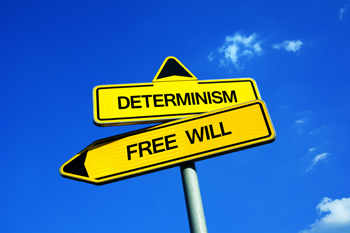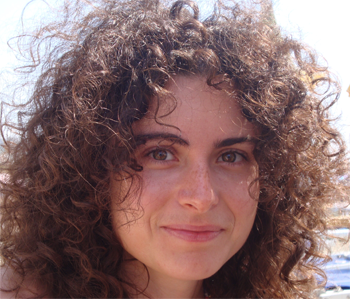
Life, choice, and other problems
In a recent Twitter poll we asked our followers if they thought they had free will. Out of the people who responded 72.5% said yes and 27.5% said no. So over 1 in 4 of these people think that all their choices are determined by something other than themselves! Why such a large proportion? Well, our Twitter followers tend to be scientifically-minded, and it's well known in physics that the concept of free will doesn't sit well with the fundamental laws of nature. Indeed those laws shed no light whatsoever on what it means to be conscious, a pre-requisite of having free will, or what it means to be alive, a pre-requisite of consciousness.

Do we have free will?
This is why we recently became interested in something called constructor theory currently being developed by David Deutsch and Chiara Marletto, of the University of Oxford, to look at the physical world in a new way. It can't as yet explain free will, or consciousness, or life. But its new perspective has potential to be applied in all these areas and has already bought about some very interesting results. Before we explore those, let's have a look at the problem of free will, and other conundrums modern physics is struggling with.
Why we can't choose...
The aim of science is to explain the world so that we can (hopefully) predict what happens next. If I kick a ball then, given you know the direction of the kick and the force I apply, you can use the laws of motion and gravitation to calculate the trajectory the ball will follow. Similarly, if I tell you the mass of a planet and its distance from the Sun, you can calculate the path its orbit takes.
Laws of physics all tend to be phrased in this way: they tell you how objects will move in response to initial conditions. "The assumption of the way in which physics currently proceeds is that everything in physical reality can be explained like this," says Marletto. "If you had a way of specifying the trajectories of all the objects of the Universe and their initial conditions, then you would have said everything about physical reality there is to say."
Physical reality includes the neurons in our brains: their behaviour is also determined by initial conditions. These initial conditions were set by processes that happened before we were born, which were in turn determined by processes that happened before our parents were born and so on, all the way back to the beginning of the Universe. "A person making a choice between two options is not really choosing," explains Marletto. "The Universe is on a trajectory, so the choice is already set in the brain and things will unfold according to whatever the initial conditions were to begin with." (You can find out more about free will and physics here.)
You might argue that our consciousness, a pre-requisite of free choice, is more than the sum of the neurons in our brain — that dismantling things into smaller components, losing sight of the whole, is the wrong approach. And indeed, there are many other phenomena that seem to emerge out of a collection of component parts and aren't served well by the current laws of physics either.
Why are some things one-way only?
Let's start with some basic physics. A litre of air contains a crazy number of molecules. The laws of motion enable us to calculate the trajectory of an individual molecule, given some initial conditions, though following through the many interactions one molecule will have with others already makes things tricky. What is more, notions like the temperature or the pressure of a litre of air in a container don't depend on individual molecules, but on their bulk behaviour. Temperature, for example, is the average kinetic energy of all the air molecules: the faster those molecules are moving, on average, the hotter the air. Indeed, concepts such as heat or work are hard to define in traditional physics.

Once you start beating this egg, you'll never be able to make it whole again.
Then there's the fact that some processes in nature appear to have a direction that can't be reversed. For example, imagine beating an egg to make an omelette. At the start, yolk and egg white will be separated but soon they will be thoroughly mixed up. No matter how long you keep on stirring, you will never see yolk and white separating out again.
This directionality is strange because the fundamental laws of physics are reversible: if a molecule can move from point A to point B, then it can also move from point B back to point A, so why shouldn't all the egg molecules be able to do this? If nature is so clearly reversible at the fundamental level, how did all the irreversibility we see every day, including not just eggs but also our ageing, enter into it?
Information and life
Another problem is life itself, which somehow emerges from the molecules and atoms that make up a cell. Darwin's theory of evolution, enhanced with newer findings about genes, is a hugely successful theory, but doesn't connect up with the fundamental laws of physics. "(Some of the) the founding fathers of quantum physics even thought the laws of quantum theory should break down when it comes to entities that are alive," explains Marletto. An example comes from the eminent Eugene Wigner, who in 1967 attempted to calculate the probability for a self-reproducing organism to exist on the basis of quantum theory. The answer he came up with was vanishingly small.
Life is intimately connected with information. For us 21t century humans information is of undeniable power and importance, but it is equally important at the level of the simplest, non-conscious, living organism: it's the information contained in DNA, and the fact that it can be copied, that enables life. Sara Imari Walker, an expert on the origin of life who is working with Marletto, even suggests that information defines life: it's precisely when information gains the power to cause changes in the physical world, for example by enabling a system to create a copy of itself, that life happens.
Yet, traditional physics has no way of defining what information actually is and how it can have the power to change the physical world.
Constructor theory

Chiara Marletto.
Perhaps what the traditional approach to physics is lacking is a grasp of the multiplicity of possibilities. If you focus on what will happen given a particular set of initial conditions, you ignore all that could have happened had the initial conditions been different. This makes it hard to look at a large system of individual components, each with its own initial conditions, in a holistic way. It also makes it hard to get a handle on phenomena that depend on there being alternatives. Information, for example, only exists when there is a multiplicity of choices: the word "yes" is only meaningful when the answer could also have been "no".
Constructor theory uses a more inclusive approach. It thinks of physics in terms of transformations: a kick transforming the motion of a ball, the Sun's gravitational pull transforming the motion of a planet, or a computer transforming input into output. The idea is to explain physical reality by stating, in a very general sense, which transformations are possible, and which are impossible. A mechanism that can cause a transformation, and can do this repeatedly and reliably, is called a constructor. The term was first coined by the famous mathematician John von Neumann when he was thinking about the evolution of life.
Human kicking balls, the Sun directing planets, and computers all count as constructors. Luckily, though, constructor theory doesn't require us to describe all these entities. Given a potential transformation it is only interested in whether a constructor that can bring it about exists (so the transformation is possible) or not (so it is impossible).
The aim of constructor theory is not to replace the existing laws of physics or to prove them wrong. It is to provide principles that laws of physics must adhere to. Principles of this flavour already exist in physics. Think of the conservation of energy, the idea that energy can neither be created nor destroyed. This principle isn't phrased in the usual initial condition/trajectory way, rather it tells you what is possible (conserve energy) and what is impossible (create or destroy it).
Conservation of energy isn't so much of a law of physics itself, rather it constrains what other laws of physics can look like: a law which violates the principle must be wrong. "The principles of constructor theory will provide constraints that have to be obeyed by dynamical laws," says Marletto. "If the constructor theory programme works out, then ultimately dynamical laws should be emergent consequences of these principles."
We look at constructor theory in more detail in this article. All we will say here is that its ability to take account of the counterfactual - the what might have been - allows it to define information in purely physical and unambiguous terms. This in turn has allowed Deutsch and Marletto to define principles they believe constitute universal laws of information. And because many physical processes involve information, or phenomena that are similar to it in their slippery nature (e.g. heat), these principles are applicable in those contexts too.
But does it work? Does constructor theory give us a handle on the kind of problems mentioned in this article, including that of free will? That's what we will look at in the next article.
About this article
Chiara Marletto is Research Fellow at the University of Oxford, and a visiting fellow at the ISI Foundation in Turin and at the Centre for Quantum Technologies in Singapore. Sara Imari Walker is Assistant Professor at Arizona State University.
Both were interviewed by Marianne Freiberger, Editor of Plus, in June 2020.